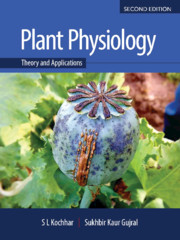Book contents
- Frontmatter
- Contents
- Foreword
- Preface to the Second Edition
- Preface to the First Edition
- Acknowledgements
- Some Common Abbreviations used in the Text
- Abbreviations for Units
- Unit I Water and Mineral Translocation in Plants
- Unit II Metabolism and Bioenergetics
- Unit III Growth and Development
- Unit IV Physiological Stress and Secondary Metabolites – Their Role in Metabolism
- Unit V Crop Physiology – An Innovative Approach
- Unit VI Breakthroughs in Plant Physiology
- Unit VII Some Experimental Exercises
- Glossary
- References
- Index
- Colour Plates
Preface to the Second Edition
Published online by Cambridge University Press: 12 May 2020
- Frontmatter
- Contents
- Foreword
- Preface to the Second Edition
- Preface to the First Edition
- Acknowledgements
- Some Common Abbreviations used in the Text
- Abbreviations for Units
- Unit I Water and Mineral Translocation in Plants
- Unit II Metabolism and Bioenergetics
- Unit III Growth and Development
- Unit IV Physiological Stress and Secondary Metabolites – Their Role in Metabolism
- Unit V Crop Physiology – An Innovative Approach
- Unit VI Breakthroughs in Plant Physiology
- Unit VII Some Experimental Exercises
- Glossary
- References
- Index
- Colour Plates
Summary
The Foundation Imprint of our book, Plant Physiology: Theory and Applications, which was first published in 2017 by CUP, India, met with an overwhelming response and the stocks were exhausted within a year or so. In a large measure, the textbook succeeded very well in addressing the need for such a tome amongst students and scholars in the fields of botany and agricultural sciences. However, review inputs and advice from subject experts overseas and within the country, as well as suggestions offered to us by the editorial staff of the Cambridge University Press, led us to considerable soul-searching on how to enhance its value.
And so, it gives us great pleasure in presenting to the readers an expanded and updated version whereby the readers can assimilate knowledge without undue effort as they imbibe; this self-contained textbook should, therefore, have a much wider appeal. The material is presented in a concise and lucid manner so that the readers can develop better understanding of the conceptual complexities in the field. We hope it will prove to be even more useful than the previous ones.
The salient features of this Second Edition are as follows:
The present edition is divided into 7 units, with a total of 23 chapters in all. In addition to the accurate and authoritative textual content in each chapter, we have endeavoured to present, through models and flow charts, more information about growth and development such as mode of action, physiological role, biosynthesis and inactivation of auxins, gibberrelins, ethylene and abscisic acid. The role of recently discovered hormones such as jasmonates, polyamines, salicylic acid and nitric oxide and others has been emphasised. The mode of action of phytochromemediated responses based on their requirements such as LFRs, VLFRs and HIRs finds a special mention. Included in the new edition are chapters on ‘Concepts of Metabolism’, ‘Carbohydrate Metabolism’, ‘Sulphur, Phosphorus and Iron Assimilation in Plants’, ‘Plant Photoreceptors’ and ‘Ripening, Senescence and Cell Death’ as well the work on Arabidopsis thaliana as an experimental tool and a model system for research in genetics and molecular biology, detailing its advantages over other plant material.
- Type
- Chapter
- Information
- Plant PhysiologyTheory and Applications, pp. xv - xviPublisher: Cambridge University PressPrint publication year: 2020



